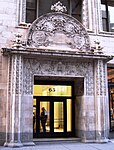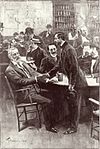Bayard–Condict Building

The Bayard–Condict Building at 65 Bleecker Street between Broadway and Lafayette Street, at the head of Crosby Street in the NoHo neighborhood of Manhattan, New York City is the only work of architect Louis Sullivan in New York City. It was built between 1897 and 1899 in the Chicago School style; the associate architect was Lyndon P. Smith. The building was originally known as the Condict Building before being renamed the Bayard Building. The building was considered to be a radical design for its time, since it contravened the strictures of American Renaissance architecture which were the accepted status quo, but had little influence on architectural design in New York City, because of its location in the industrial area that Bleecker Street was during that period. It is located in the NoHo Historic District. The building was designated a New York City landmark in 1975, and has been a National Historic Landmark since 1976.
Excerpt from the Wikipedia article Bayard–Condict Building (License: CC BY-SA 3.0, Authors, Images).Bayard–Condict Building
Bleecker Street, New York Manhattan
Geographical coordinates (GPS) Address Nearby Places Show on map
Geographical coordinates (GPS)
| Latitude | Longitude |
|---|---|
| N 40.726388888889 ° | E -73.995 ° |
Address
Le Pain Quotidien
Bleecker Street 65
10012 New York, Manhattan
New York, United States
Open on Google Maps







